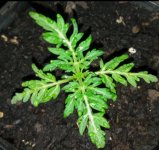Ruderialis isn't actually a separate species of Cannabis, "ruderal" literally translates to recently wild or "weedy". Technically every strain of cannabis has some ruderal or feral linage, even if very distant. This is why many true landrace sativa strains from regions where cannabis is found feral often exhibit phenotype which display these beady traits, due to wild airborne ruderal cannabis pollen contaminating outdoor cannabis farms. This can be seen in the Nanda Devi strain I referenced earlier availabe from TRSC.
My understanding is that there is still no consensus on how to classify c. ruderalis? I agree that ruderal often is translated as weedy or wild. Ruderal is also describing plants that first grow and colonise disturbed land, like after a fire. Also after landslides, plowing, construction, etc.
I would say a ruderal cannabis is not the same as cannabis ruderalis, though. One trait that defines ruderalis is the autoflowering one. A ruderal cannabis plant found in the highlands of India would probably not flower in time if planted in northern Europe? Enlighten me if I'm wrong.
Some ruderal plants may pollenate landraces, yes. Anything might result from that cross, I guess, depending on the genes in the pollen.
I have too little knowlegde to comment with certainty, and these are just uneducated opinions.
C. Ruderalis is a building block in all autos, and when bead phenos occur in autos, I am pretty sure it comes from the ruderalis genes.
I agree that technically all strains have a feral lineage, as they all have evolved from a population that once grew wild, if we go way back.
I also think that the beady phenos that we are looking for are traits that once were common in all cannabis if we go back to the origin. The earliest plants probably had very small and sparce buds, and humans eventually increased potency and bud size through cultivation.
Strains like nanda devi haven't been worked towards bigger buds, and so they are closer to the old feral strains in their genotype.
I am sure beady phenotypes are due to the trait being inherent because it is not bred out. I don't think the pheno only shows up when the farm is contaminated by airborne feral pollen, though I'm sure that might increase the ratio..



